
Babou Ceesay and Andrew Garfield in The Overwhelming
We’re having a bit of a clear-out! So snap up these three collections of enthralling plays which we’ve put together at discount prices.
2 books | £6 including UK p&p
Two richly imagined thrillers full of humour and strong characters.
Bang Bang Bang
by Stella Feehily
Two young women – human rights observers – head to the Democratic Republic of Congo to seek out a dangerous and charismatic young warlord. They’re part of a community of aid workers, medics, journalists, advisers and photographers who keep coming back for one last mission; for whom life back home is too small compared with the danger – and debauchery – of life without borders. “Wonderful writing. Stella Feehily’s best work to date” Whatsonstage.com
The Overwhelming
by JT Rogers
Jack Exley uproots his family from Illinois to Rwanda, in order to research a book and seek out an old friend. But his wife and teenage son soon get into trouble, in a country where tensions are about to spill over into horror. “Devastating power” Sunday Times
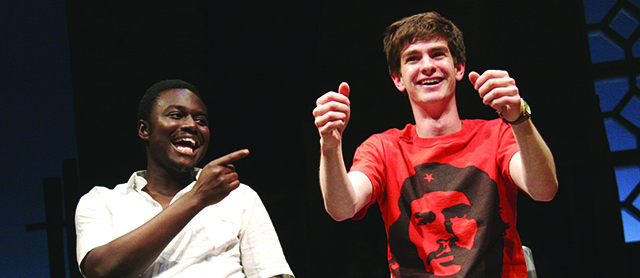
Babou Ceesay and Andrew Garfield in The Overwhelming
We’re having a bit of a clear-out! So snap up these three collections of enthralling plays which we’ve put together at discount prices. Great presents, whether for you or someone else.
AFRICAN ADVENTURES
2 books | £6 including UK p&p
Two richly imagined thrillers full of humour and strong characters.
Bang Bang Bang
by Stella Feehily
Two young women – human rights observers – head to the Democratic Republic of Congo to seek out a dangerous and charismatic young warlord. They’re part of a community of aid workers, medics, journalists, advisers and photographers who keep coming back for one last mission; for whom life back home is too small compared with the danger – and debauchery – of life without borders. “Wonderful writing. Stella Feehily’s best work to date” Whatsonstage.com
The Overwhelming
by JT Rogers
Jack Exley uproots his family from Illinois to Rwanda, in order to research a book and seek out an old friend. But his wife and teenage son soon get into trouble, in a country where tensions are about to spill over into horror. “Devastating power” Sunday Times
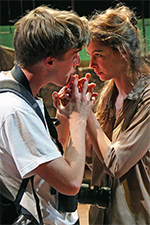
Bang Bang Bang
WOMEN AT WORK
3 books | £9.50 including UK p&p
Ciphers
by Dawn King
When Justine is found dead, her sister Kerry suspects foul play. Her investigations unearth revelations about the seemingly quiet and unassuming Justine – her work in the secret services, and her affair with a married artist. Are the two things linked? “An ingenious thriller about spies, surveillance and doubleness” The Guardian
London Wall
by John Van Druten
Wryly funny, moving and startlingly modern, this 1931 play set in a solicitors’ office in the City enjoyed much praised revival a couple of years ago. It teems with gossip, romance, competition and ambition – and in its shrewdly observed office and gender politics, it feels like a forerunner to Mad Men. “Both dramatically engaging and a fascinating theatrical time-capsule” Daily Telegraph
Bang Bang Bang
by Stella Feehily
Two young women – human rights observers – head to the Democratic Republic of Congo to seek out a dangerous and charismatic young warlord. They’re part of a community of aid workers, medics, journalists, advisers and photographers who keep coming back for one last mission; for whom life back home is too small compared with the danger – and debauchery – of life without borders. “Wonderful writing. Stella Feehily’s best work to date” Whatsonstage.com

Jane Wenham…
OUR HISTORY
3 books | £9.50 including UK p&p
Jane Wenham: The Witch of Walkern
by Rebecca Lenkiewicz
Inspired by events in a Hertfordshire village, this haunting, gripping play examines sex, religion, nature and superstition through the story of a local “cunning woman” accused of witchcraft by a zealous but inexperienced young priest. “A heady brew of sex and sorcery” The Guardian
Pitcairn
by Richard Bean
Like an adult Lord of the Flies, Richard Bean’s ambitious and funny play tells what happened after the mutiny on The Bounty. Fletcher Christian and his followers hide out on a remote island, and dream of building a perfect society without hierarchy. It goes brutally, horrifically awry. “A rip-roaring tale, rich in metaphorical resonance” Daily Telegraph
A Dish of Tea with Dr Johnson
by Russell Barr, Ian Redford & Max Stafford-Clark
A glorious, humane celebration of Samuel “dictionary” Johnson, his work and his words. A man whose impatience matched his wit; whose kindness belied his own ill health; and whose phenomenal intelligence did not make him any less vulnerable to the pains of unrequited love. A treat, this. “Every line chimes” The Times
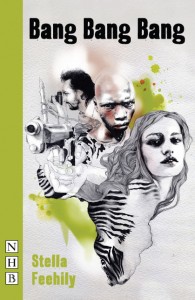 Nick Hern Books £3.50 (for a limited time, RRP £9.99)
Nick Hern Books £3.50 (for a limited time, RRP £9.99)
Based on extensive research, this is a thrilling new adventure about Human Rights defenders in the Democratic Republic of Congo.
“You get a cook, a cleaner, a driver and you get paid. I’ll be watching out for you.”
For Mathilde, young and idealistic, it’s an induction into a life less ordinary. For the more seasoned Sadhbh it’s back to madness and chaos away from her lover and London – exactly as she likes it. While Mathilde lets off steam with a photographer and a spliff, Sadhbh has her own encounter: tea with a smart, brutal young warlord she’s investigating. Or is he investigating her?
Stella Feehily brings her trademark wit and emotional insight to this revealing look behind the public face of charities, journalists and NGOs.
]]>“Wonderful writing. Stella Feehily’s best work to date”
Whatsonstage.com
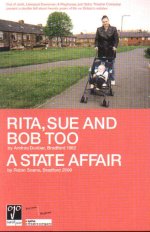 Methuen £2.50 (rrp £7.99) OR buy 3 brilliant Robin Soans docu-plays for £11.50 including postage
Methuen £2.50 (rrp £7.99) OR buy 3 brilliant Robin Soans docu-plays for £11.50 including postage
Dunbar’s famous play of two teenagers and the married man they fall for. In a volume with Robin Soans’ mindblowing documentary play about the Bradford estate on which Dunbar grew up, finding hope and heroism in the aftermath of a heroin epidemic.
“heartbreaking… unmissable… a massive achievement” Time Out
EXTRA: includes information about the research that went into A State Affair, a discussion on the stage design considerations, and more.
]]> Faber and Faber £3.00 (rrp £8.99)
Faber and Faber £3.00 (rrp £8.99)
JT Rogers’ gripping thriller focuses on an American family in Rwanda, immediately prior to the 1994 genocide. As Jack searches for his mysteriously disappeared friend, his wife becomes close to a powerful politician and his teenage son finds escape – and danger – in Kigali’s nightclubs. A hit at the National Theatre and on tour.
“A gripping political thriller” Time Out
“The best new play I have seen this year and one of the most entertaining” Daily Telegraph
“Devastating power” Sunday Times
EXTRA: includes an article on Rwanda by Fergal Keane and extracts from research interviews conducted in the country.
]]> Faber | £13 (rrp £16.99)
Faber | £13 (rrp £16.99)
The Grace of Mary Traverse (Royal Court)
Plays and Players Most Promising Playwright Award
A vividly imaginative story about the pretty, carefully-schooled daughter of a wealthy London merchant who becomes tired of her pampered life and goes in search of real-world experience on the streets of 18th Century London, with both comic and perilous results.
Our Country’s Good (Royal Court and Broadway)
Laurence Olivier Play of the Year Award
New York Drama Critics’ Circle Award for Best New Foreign Play
Now revived by Out of Joint, this much loved play is about convicts newly arrived in an Australian prison colony who are tasked with putting on a play for the King’s birthday.
Three Birds Alighting on a Field (Royal Court)
Susan Smith Blackburn Award, Writers’ Guild Award and London Critics’ Circle Award
We gave a rehearsed reading of this play recently alongside our production of Our Country’s Good, to an audience at the St James Theatre. It went down brilliantly: very fresh and funny. Three Birds… is a playful, smart satire on the art world. But it is also the touchingly-told story of a woman’s self-discovery through art, and of her Greek husband’s quest for Englishness – whatever that is.
The Love of the Nightingale (RSC’s Other Place)
Eileen Anderson Central TV Drama Award
“A stunning adaptation of the Philomele myth written with grace, authority and economy” Time Out
New Anatomies (ICA)
The story of the dramatic and eventful life of Isabelle Eberhardt, a turn-of-the-century, fiercely independent European adventurer who disguised herself as an Arab boy and traveled with nomadic tribes in Northern Africa
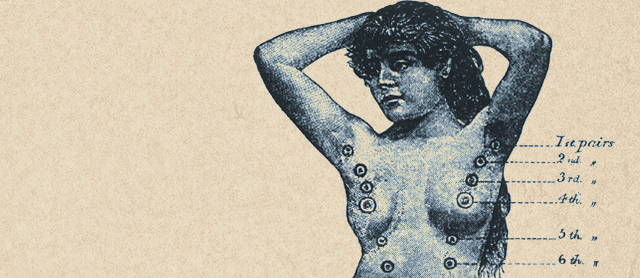
In August 2015, villagers in the Indian state of Jarkhand dragged five middle-aged women from their beds and beat and stoned them to death on suspicion of witchcraft. It wasn’t an isolated case. In India’s eastern states, “witches” are often blamed and attacked for causing illness, poor harvests and other misfortunes. There’s a horrid timelessness to the phenomenon: it echoes accusations made through history as people sought to explain nature’s cruel mysteries. But in 2015 with all our shared wealth of accumulated scientific knowledge it shocks that such wild ideas can still bring a mob to murder.
Rebecca Lenkiewicz’ new play Jane Wenham: The Witch of Walkern is inspired by the case of a Hertfordshire village’s “healing woman” in 1712 – one of the last witch trials in England. We’re touring the play across England and we’ve dug up some stories of witch persecutions and other happenings near to the theatres we’re visiting. There are stories of strange apparitions, superstitions, religious fundamentalism and con-artistry. Some are fascinatingly odd; others just heartbreaking.
HERTFORDSHIRE: THE PAUPERS OF TRING
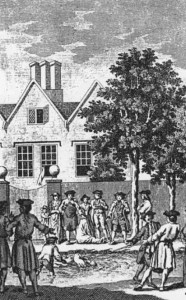 Walkern, where our play is set, is in Hertfordshire but here’s another piece of local witch history.
Walkern, where our play is set, is in Hertfordshire but here’s another piece of local witch history.
Ruth and John Osborne were elderly paupers who lived in a workhouse in Tring. In 1751 they were both tried and executed for witchcraft, despite the Witchcraft Act outlawing such punishment in 1732. Ruth Osborne went begging for food at the residence of local farmer John Butterfield, who turned the old woman away. Ruth left, muttering obscenities towards him under her breath. In the fllowing weeks, Butterfield began to suffer from fits and his cattle too fell ill. He accused Ruth of having cursed him and declared that she and her husband were witches.
An angry mob descended on the workhouse where they stayed and dragged them to a muddy river where their hands and feet were bound together, and both were ‘ducked’ in the water. Having choked to death on the mud, Ruth’s naked body was left on the riverbank, while John died later from his injuries and shock. The leader of the mob, Thomas Colley, was tried in Hertfordshire Assizes and condemned to death as a murderer. Local authorities pressured Colley to renounce his belief in witchcraft, which he did, before being taken back to Tring and hung for his crimes. Despite this, the local villagers supported Colley and continued to believe that Ruth Osborne was a witch.
Jane Wenham: The Witch of Walkern plays at Watford Palace Theatre from 23 September.
SUFFOLK: THE BRANDESTON MARTYR
 In 1596, John Lowes became the vicar of All Saints in the Suffolk village of Brandeston. He was not yet 30, and was to remain in the role until he was killed at the age of 80.
In 1596, John Lowes became the vicar of All Saints in the Suffolk village of Brandeston. He was not yet 30, and was to remain in the role until he was killed at the age of 80.
Priests like Lowes, who were associated with the “high church” and its rituals, were viewed with increasing suspicion by a puritan-leaning local population who wanted the Church of England to resemble more closely the protestant churches of Europe. They could be prosecuted as “scandalous minsters” – but Brandeston’s puritans took things further and with a nod from the Witchfinder General Matthew Hopkins, Lowes was charged with witchcraft. The old man, who had served his parish for 50 years, was tortured until he confessed to employing two imps to sink ships at sea. He was taken to Bury St Edmunds, where he was among 40 innocent men, women and children to be executed in the autumn of 1646.
Jane Wenham: The Witch of Walkern tours to Brandeston and other rural locations in Suffolk, Essex and Norfolk from 6-17 October.
YORKSHIRE: THE LAST BURNING AND MORE
Old Wife Green
Hanging was the usual method of execution for witches, rather than the more expensive burning. The last burning of a witch in England was in 1630 in Pocklington, East Yorkshire, where the parish register records Old Wife Green was burned for being a witch by an angry mob in the village square.
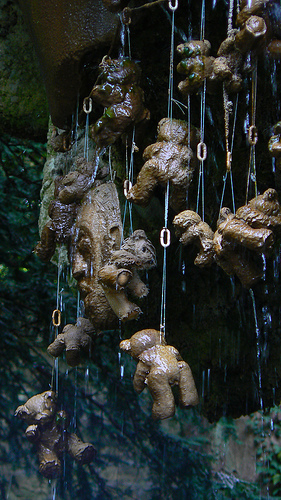
Toys petrifying at Mother Shipton’s cave, now popular with tourists
Mother Shipton
The famous ‘witch’ of Yorkshire was born in a cave in Knaresborough in 1488 during a violent thunderstorm. Her mother died giving birth. Mother Shipton’s original name was Ursula Southeil. Throughout her childhood she was associated with many mysterious events, such as furniture moving of its own accord and bright lights coming from a property. She became well known as a fortune teller but her crooked facial features frightened many and she was often thought of as a witch. She’s associated with many famous predictions, including foretelling the Great Fire of London and the defeat of the Spanish Armada. Mother Shipton’s cave still exists and attracts visitors from all over the world to see the magic power of the well near the cave which can turn things to stone: Objects, such as teddy bears and dolls, are hung up inside the cave and the limestone-drenched water from the petrifying well gradually turns the objects to stone with its sediment.
Mary Bateman
A criminal and alleged witch known as the Yorkshire Witch. She was tried and executed for murder during the early 19th century. She became a prominent fortune-teller in Leeds who prescribed potions which she claimed would ward off evil spirits. She poisoned a couple who asked for her help in lifting a curse and was found guilty by a jury of fraud and murder. She was hanged in 1809 in York and her body put on public display with strips of her skin sold as magic charms to ward off evil spirits. Her skeleton is on display to the public in the Thackray Medical Museum in Leeds.
Jane Wenham: The Witch of Walkern tours to West Yorkshire Playhouse 21-24 October.
NORTH WEST: THE WOMAN WITH THE LANTERNS
Llanasa in Flintshire is a village near the North East coast of Wales, just across the Dee estuary from The Wirral. Around 1,000 people, many of them seafarers, lived there in 1665 when charges of witchcraft were brought against a local woman, Dorothy Griffith.
Her two main accusers were William Griffith, a sailor, and Thomas Rogers, an ale-house keeper. William Griffith said that he had been walking at night to the ship in which he served, when Dorothy had come towards him “with many lanterns lighted about her”, and had led him to Rogers’ house whereupon he looked back towards the marsh and saw it was “soe covered with fire and light that one might have gathered needles”. He fell into a trance, and the next morning sent for Dorothy. When she subsequently prayed for him he recovered.
This was the middle of the 17th century, when witch persecutions were at their height. The judges who presided over the Dorothy’s trial, John Bradshaw and Thomas Fell, had sent several women to the gallows for witchcraft. Dorothy seems to have been saved by her fellow parishioners, 31 of whom signed a petition in support of her. As J. Gwynn Wiliams wrote in the Journal of Flintshire Historical Society, “it is remarkable testimony to the sense of fairness of the chief parishioners of Llanasa that they unequivocally came to the aid of a defenceless spinster, so often the victim of persecution in less favoured communities.”
What did William Griffith see that night? Marsh gas or methane that had somehow caught fire, perhaps, or ball lightning or phosphorescence. There was a popular idea at the time of “corpse candles” – lights or flames which would appear when a nearby death was imminent. This would explain Griffith’s terrified state.
Jane Wenham: The Witch of Walkern tours to Liverpool Everyman Theatre 27-31 October.
WEST COUNTRY: HAG RIDING IN WESTON-SUPER-MARE
 Hag-riding was the alleged practise of disturbing others in their sleep, and provided an explanation for phenomena such as sleep paralysis and what the academic David Hufford has called “sensation of presence” – that feeling we’ve all had at night of someone or something being in the room.
Hag-riding was the alleged practise of disturbing others in their sleep, and provided an explanation for phenomena such as sleep paralysis and what the academic David Hufford has called “sensation of presence” – that feeling we’ve all had at night of someone or something being in the room.
In 1875 in Weston-super-Mare (just along the Severn Estuary from Bristol which we’re touring) 72 year old Hester Adams was prosecuted for stabbing 43-year-old Maria Pring in the hand and face. Adams accused Pring of having hag-ridden her and her husband on many occasions, and though conceding that ‘she does not come bodily” she claimed Pring would be present in “a nasty, evil, spiritual way, making a nasty noise.” Adams had concluded she must draw blood from Pring in order to stop her ridings, hence the stabbing – for which she was fined one shilling, and bound to keep the peace. Had it been 200 years earlier, it would likely have been Pring in the dock.
Jane Wenham: The Witch of Walkern tours to Bristol’s Tobacco Factory Theatres 3-7 November.
SALISBURY: THE HEALING WOMAN OF FISHERTON
Anne Bodenham lived in the Fisherton area of Salisbury (a five minute walk from where Salisbury Playhouse is now) and, like Jane Wenham, worked as a cunning woman, teaching children to read, recovering lost items and curing illnesses.
The Goddards, a gentry family who lived in the Cathedral Close, sent their servant Anne Styles to Bodenham for advice on misplaced items and family disputes. Tensions within the family began to escalate: Mrs Goddard became convinced that her daughter in law, Sarah, was trying to poison her, and there was a law suit between Goddard and one of his sons-in-law. When Bodenham’s assistance in these matters was sought, Styles witnessed unusual sights, such as ragged spirits appearing and, when a green “scrying glass” (like a crystal ball) was placed on a book, she could see persons in her Master’s house.

Inquisitors would search the body of a suspected witch for Devil’s marks or extra teats
Styles was asked by Bodenham to purchase arsenic, which was mysteriously burned to prevent the poisoning of Mrs Goddard. Over the next few days Styles visited Bodenham and witnessed her displaying diabolical pictures, calling on the devil to conjure up evil spirits, and using the scrying glass to discover arsenic under Sarah Goddard’s bed.
Bodenham sent Styles to collect herbs which, along with the witch’s nail parings, would be put in Sarah Goddard’s drink to make her drunk, mad and her teeth fall out. These arrangements came to the attention of Sarah Goddard and, when it was discovered that Styles had bought arsenic, the family dismissed her. On Styles’ final visit to the “witch”, Bodenham attempted to persuade her to stay with her and, when Styles refused, she made her take a vow of silence, signed in her own blood in the witch’s book of the devil.
Styles set off for London but she was returned to Salisbury by one of the Goddard’s son in laws. On her return she confessed and fell into a coma racked with terrible convulsions. Styles and Bodenham were charged with attempted poisoning and committed to Fisherton gaol.
Anne Bodenham was tried at the Lent Assizes, found guilty of witchcraft and sentenced to death. She refused to admit her guilt, even though the marks of a witch* were found on her body, and would not pray or be prayed for or reveal the whereabouts of her magic or other witches in the area. Anne Bodenham was hanged in 1653.
*Inquisitors would search the body of a suspected witch for marks made by the Devil, or for teats from which a familiar or the Devil himself could suck. Skin infections, the hint of an extra nipple or moles and other marks could be interpreted as Devil’s marks.
Jane Wenham: The Witch of Walkern tours to Salisbury Playhouse 10-14 November.
DALSTON, LONDON: EXORCISM
In 2005, Sita Kisanga and her brother Sebastian Pinto were found guilty of aiding and abetting the physical abuse of an eight-year-old girl. The girl’s aunt, who had brought the girl to the UK after her parents died, was convicted of child cruelty. The girl had been beaten, cut and had chilli peppers rubbed in her eyes to ‘beat the devil out of her’.
Kisanga and Pinto, attended the fundamentalist Combat Spirituel church in Dalston, east London. At the trial, Dr Richard Hoskins, an expert on African religions, said that what marked such churches out from the mainstream was the practice of exorcism.
Kisanga denied she had taken part in the beatings of the girl and said that she had tried to stop the abuse by the child’s aunt. But she admitted that like the aunt she had believed that the girl was ‘kendoki’ – a witch.
Jane Wenham: The Witch of Walkern is at Arcola Theatre, Dalston, 5-30 January 2016.

DAVID ACTON
David has appeared in many productions for the RSC and has toured with Ed Hall’s acclaimed all-male Propeller company. Other theatre includes The Woman in Black in the West End and Richard II at the Old Vic.
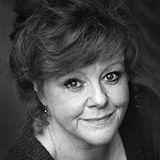
AMANDA BELLAMY
Amanda’s theatre includes A Little Hotel on the Side at the National Theatre and several productions at the RSC including Hermia in John Caird’s A Midsummer Nights Dream and Lady Haughty in Danny Boyle’s Epicoene. She was Winnie in Happy Days at BAC, starred in national tours of The Price and Girls’ Night Out, and her many performances for Salisbury Playhouse include Elizabeth Bennett in Pride and Prejudice. She played Rose in three series of You Rang M’Lord, Hetty in Searching and has appeared in Bergerac, All in Good Faith and Terry and June.
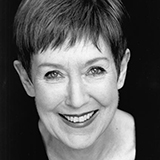
JUDITH COKE
Judith has worked extensively at the National Theatre, including the David Hare trilogy, Hamlet, Tales from the Vienna Woods and more recently Madame Duplay in Danton’s Death. Other theatre includes A Day in the Death of Joe Egg (West End) and As You Like It at Regent’s Park Open Air Theatre.

TIM DELAP
Tim played Siegfried Sassoon in Regeneration for the Royal and Derngate’s national tour. West End appearances include The Woman in Black, The History Boys, The Old Country and As You Desire Me. An extensive television career includes Poldark, Peaky Blinders and Black Mirror.

HANNAH HUTCH
Hannah recently appeared in The Skriker alongside Maxine Peake at the Royal Exchange for Manchester International Festival. Other theatre includes Tis Pity She’s A Whore (Shakespeare’s Globe) and The Crucible (Old Vic). TV includes Doctors.

PATTI LOVE
Patti’s West End credits include The Prisoner of 2nd Avenue, Serious Money and Lysistrata. She has performed at the National Theatre, RSC and Royal Court and played Amanda in The Glass Menagerie at Exeter Northcott. Her films include The Long Good Friday, Mrs Henderson Presents and The Krays, and TV includes Middlemarch and Moll Flanders.

ANDREW MACKLIN
Andrew has performed in several productions for Dublin’s Abbey Theatre. Other theatre includes The Beauty Queen of Leenane (Curve theatre), I’ll Be The Devil (RSC/Tricycle), The Mercy Seat (York Theatre Royal) and Much Ado About Nothing (Bath Theatre Royal). On television, Andrew was a regular on RTE’s Fair City.

RACHEL SANDERS
Rachel’s theatre work includes War Horse in the West End and other National Theatre productions including His Dark Materials, The Bacchai and Othello. She has appeared in several RSC productions, and has numerous TV credits.
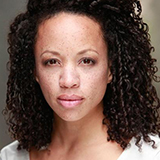
CAT SIMMONS
Cat is best known as series regular Emma in the hit BBC1 drama Ordinary Lies, as well as series regular DC Kezia Walker in The Bill and Scarlett Anderson in Family Affairs. She played opposite Ian McKellen in panto at the Old Vic and has worked at the Arcola, Young Vic and Shakespeare’s Globe. She has just finished shooting a new Victoria Wood film, Tubby and Enid, for the BBC.
RIA PARRY – Director
Ria is Co-Artistic Director of Iron Shoes, for whom her productions include Mad About The Boy (Edinburgh Fringe and National Tour – Fringe First winner 2009), Caryl Churchill’s Fen
JAMES BUTTON – Designer
James has designed extensively for Salisbury Playhouse, Watford Palace Theatre, the Unicorn Theatre and elsewhere. He collaborates regularly with Ria Parry.
RICHARD HOWELL – Lighting Designer
Richard’s work includes East is East (West End and tour), The Invisible (Bush Theatre), Little Shop of Horrors (Manchester Royal Exchange) and operas for Holland Park Opera. See more of his work on his website.
MAX PAPPENHEIM – Composer and Sound Designer
Max has worked at theatres including the Park Theatre, Almeida Theatre, Orange Tree Theatre, Southwark Playhouse and The Finborough. He has been nominated several times for Off West End Awards.
]]>
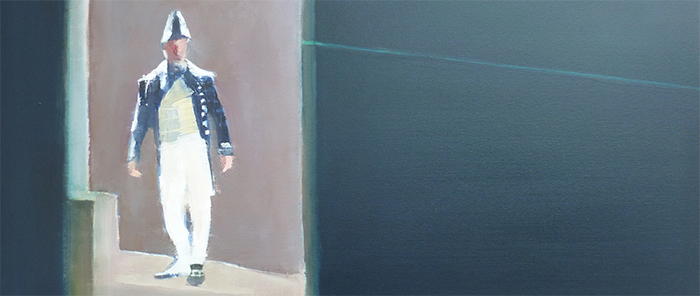
Detail from “It’s a damned paradise”
JON BRADFIELD talks to artist Pippa Blake about her new theatre-inspired exhibition.
Theatre’s a pretty transient art-form – once the last performance is over and the lights go down, it’s over. The cast moves on to other projects, the costumes are sent back and dry-cleaned, and we get on with the business of planning our next tour.
So we’re excited to have an unusual, permanent artistic legacy to one of our recent shows. The painter Pippa Blake joined us in rehearsals last year for our production of Pitcairn, a new play by Richard Bean about the colonizing of a South Pacific island in 1789. Pippa has completed a series of paintings inspired by the piece which are about to go on display (see dates below). Some clearly show their origins in the theatre production, while others seem to take us onto the island itself.
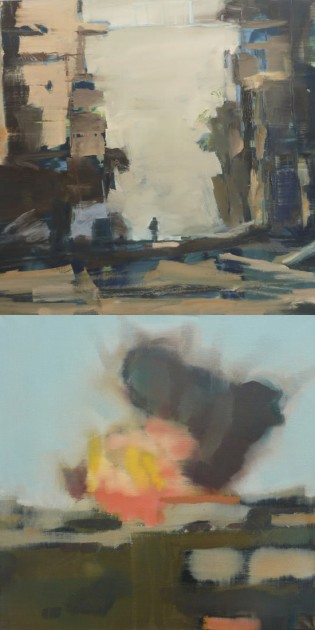
Two paintings by Pippa Blake
Was this the first time you’ve used theatre as a starting point?
I’d never used the theatre as a starting point before but the idea came to me while watching Howard Barker’s play Scenes from an Execution at the National Theatre in 2012. Everything resonated – I’d been making war paintings, and here was a 16th Century female war artist struggling in a male dominated world and wanting to show the truth, not what the bureaucrats wanted her to depict.
How did those war paintings come about? Those scenes of bombed cities and military helicopters, what was your source for them, and what are you trying to do with them?
I have been interested in war since studying the First World War poets at school. Wilfred Owen’s ‘Strange Meeting’ had a profound impact on me – I remember scribbling skeletons on essay papers at the time. I started out a landscape painter, then around ten years ago wanted to be saying more about the world. All the images of the Middle Eastern war on television began to affect me and move me towards making work – as well as the anniversary of Auschwitz in 2005 and the powerful images from 9/11 also. There is something about the soulfulness and loneliness of the bombed street scenes, which resonates with something inside of me, and perhaps I am trying to show that within the work
Your Pitcairn paintings evoke the production but you also spent time in rehearsals.
That was crucial. Although I haven’t used the drawings I made during them it gave me a greater insight into how a play is made and to get to the very bones of how life is breathed into it. It helped me understand what was behind the story of Pitcairn.
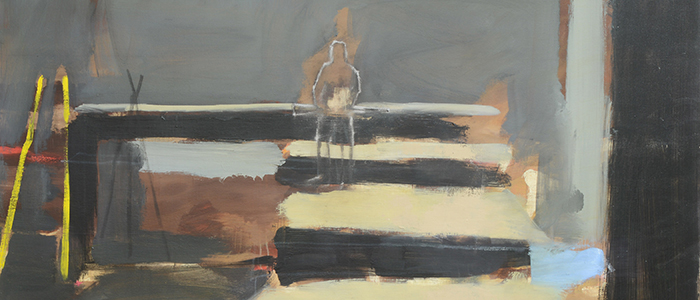
Detail: The Rehearsal
Aside from sketching, how was the experience of watching the play being rehearsed?
Artist or not I found the rehearsals fascinating, listening to Max Stafford-Clark challenging the actors in getting into the character of their parts. I felt it was a privilege to be an onlooker and not only to watch the characters take shape and how they worked with each other but also how the actors reacted with each other personally.
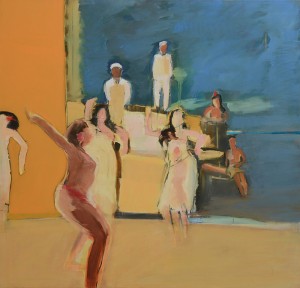
Be strong we are taking control
Are you much of a theatregoer?
I grew up near Chichester Festival Theatre and was taken by my parents early on and there were school visits to Stratford and the Yvonne Arnaud at Guildford. During art school at Camberwell we would get cheap seats to the National. I would call myself a keen theatergoer who doesn’t go often enough.
Some of your paintings have been very abstract, some figurative, some are somewhere between the two. Do you always know when you start painting where you’re going to land between those two extremes?
That is a good question for me as I have been a very abstract painter and never a very figurative painter, at least in terms of realism. And of course the very nature of working with the theatre means that figures come into play. I never know when I begin a work what is going to happen on the canvas. I have an image as a starting point –a photograph or a drawing – and during the process of making the painting I lose the original photographic image, return to it, and then might lose it again. It used to worry me that I had these two apparently different approaches but now rest easy with the fact that I could go either way and perhaps have two styles – look at the work of Gerhard Richter to see how he sits within the two ways of working.
So when do you have an idea of what the finished painting will be?
It’s something I arrive at. Quite often I will completely change the painting and begin a new one on the same surface, which seems to be establishing itself as the way I work. Really I need to have many layers of work on the canvas until I begin finding what it is I am searching for.
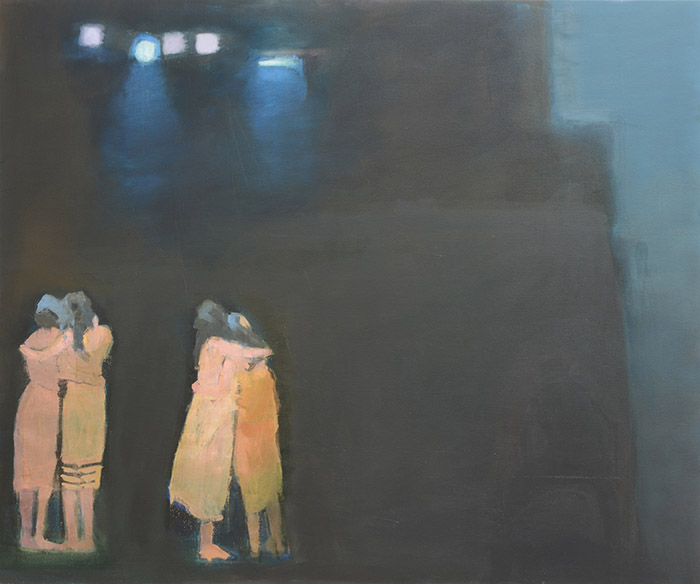
Our sentence a life sentence
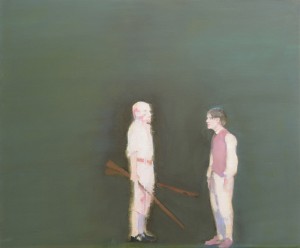
We’re a crop and we have a blight
In one of the Pitcairn paintings there’s a definite suggestion of theatre lighting, and another is called “the rehearsal”, but in most of them there’s no inherent reference to their genesis in a theatre production. So what do you think the paintings are “of”? Are they a recording of actors in 2014 performing a play about people and events on Pitcairn in 1789; or do they somehow bypass the show to become a depiction of the people and events on Pitcairn themselves? To put it another way: Are the clothes in these paintings the costumes from the play, which clearly they resemble; or are they the naval uniforms and Tahitian dress from 1789?
They are certainly the costumes from the play because the paintings could never have emerged without my experience of the play. However I would like to think that I have taken the paintings beyond the visual level of the theatre production in that there is very little direct reference to the stage-set (apologies to designer Tim Shortall!) although I was initially very inspired by the drama of his sets.
What is important is that I get across an emotion or feeling of atmosphere about the bones of the play. I ‘m trying to pare down to the essence of what is going on. I am also well aware of recent goings on in Pitcairn Island and the historical implications of life on the island that I am also mindful of in the work.
Do you generally work in phases, or series? I mean, you generally work on a number of pictures on a theme or style at the same time or in close succession?
Yes – I like to treat the work as a project involving investigation and research, so work on a series of paintings with the same subject matter. I work on several canvases at once – one reason is purely practical in that working in layers with oil paint I need to wait for paint to dry! And I like to be able to imbue the same spirit into all the works. so it is helpful to not stop and start one at a time.
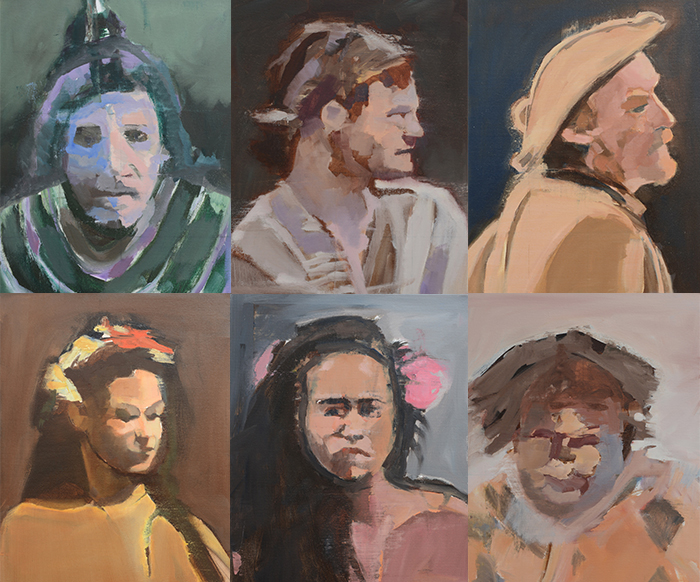
Six paintings of characters from Pitcairn
What artists do you like? Current and historical
I grew up looking at Cezanne, Bonnard, Matisse and then Richard Diebenkorn, Willem de Kooning, Mark Rothko and Philip Guston. Current artists I look at are Anselm Kieffer, Gerhard Richter, Peter Doig, Cai Guo-Qiang, Tacita Dean and Adrian Ghenie amongst others.
Do you buy much art?
I used to buy work from artist friends but not so much these days – artists are not normally in a position to buy much art. When I visit galleries and exhibitions I like to decide which would be the one I would take away with me were it possible.
How do you spend your time when you’re not painting?
I travel a great deal and spend time in New Zealand, which is second home for me. I love walking up hills, watching movies, going to theatre, reading, drinking wine and I love dancing. I also have a small wooden boat, which I love to sail on fair weather days.
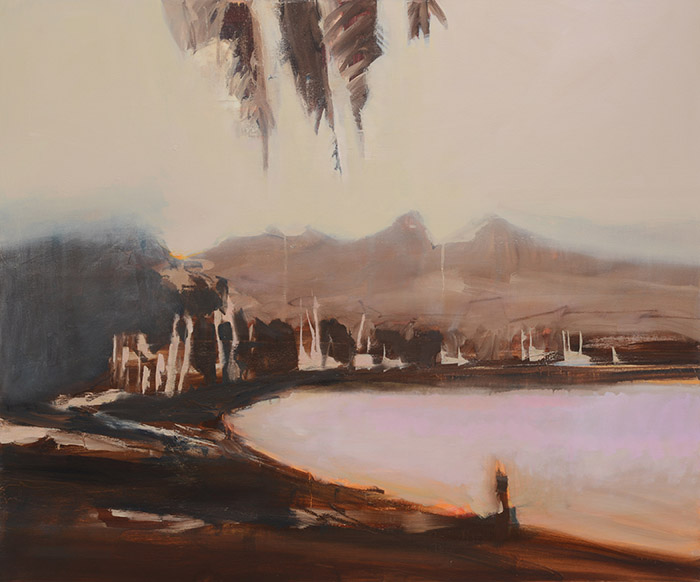
Paradise
You’ve travelled a lot. Best three places/experiences?
I’ve spent time in French Polynesia and love the island of Tara – vanilla plantations, lush and warm. I’ve spent time in the Amazon on an expedition boat, working as an artist with the sense of being surrounded by a vast forest and its remoteness. Likewise sailing across the Indian Ocean, being on the dawn watch as the sun rose and feeling the vastness of the ocean and world around you. A very recent trip to China was fascinating and inspiring to go back to learn more about it’s history and politics.
Has your art been influenced by art you’ve encountered from different culture when you’ve travelled?
No, I don’t feel I’ve been influenced particularly from the art of different cultures although back in the late 70’s going to New York and seeing the Abstract Expressionists first hand had a huge impact on me – particularly Willem de Kooning, Franz Kline and Philip Guston.
See the Pitcairn pictures here:
Pippa Blake | Utopia : Dystopia
26-31 May: Embassy Tea Gallery, 195-205 Union Street, London SE1 0PB
5-17 June: West Dean Collage, Nr Chichester, West Sussex, PO18 0QZ
INSET DAY: Max Stafford-Clark on Verbatim Theatre
“A great day. A genuine privilege” Jeremy Eden, Hayes School Bromley
Response to a previous Out of Joint inset day
We are proud to announce Out of Joint’s next Inset day. Our previous inset days in London have proved popular and successful. This time around we invite you to join Max Stafford-Clark and special guests on April 22nd 2015 for a day exploring Verbatim Theatre. The day will focus on the process of creating a piece of theatre from research and interviews, discussing past Out of Joint verbatim productions and using Max’s rehearsal methods. We will be hosted at Liverpool’s Everyman Theatre on Hope Street, a 10 minute walk from Liverpool Lime Street Station.
The inset day costs £160 and includes lunch and a ticket to see that evening’s performance of Crouch, Touch, Pause, Engage by Robin Soans – Out of Joint’s new verbatim play about Welsh rugby star Gareth Thomas and his hometown, Bridgend.
The day will begin at 10.30am with a meet and greet, followed up by the workshop. Lunch break will be at 1pm and then there will be a discussion on a variety of Out of Joint verbatim productions and their development process. The day will finish with a Q&A and a break before the play at 5.30pm.
BOOKING
For more information about the day and to book your place, send an email via [email protected]. You can also call us on 020 7609 0207.
Here are responses to some previous inset days:
“The most inspiring and fun INSET ever. Max is such a fascinating fund of practical, and academic, knowledge” Caroline Fooks, Reading School
“I have been a teacher for nearly 20 years and have attended many and various training days but the session at Out Of Joint was the most enjoyable, useful and genuinely inspiring that I have experienced” Lucy Huntbach, Salford City College
“I think the day was very valuable and very much informed my teaching. I felt it has given me a wealth of information and strategies to use with my A Level students studying the text. Having Max and the actors/ designers there gave it a real authenticity and increased the experience.” Rob Smith, St. Augustine’s Catholic College
“Very useful and enjoyable” Roz Duffin, Colyton Gramma School
]]>